Do you ever find yourself wondering what all those numbers on your multimeter mean? Well, today is your lucky day! We’re going to take a look at True-RMS multimeters and explain exactly what they are and how they work. So grab a cup of coffee and get comfortable, because here we go!
What Is a True-RMS Multimeter?
Standard meters only read steady state signals from sine waves, meaning they don’t respond well to varying levels of amplitude or frequency changes. This can be problematic for some types of electronics that operate on alternative power sources like solar cells or batteries. On the other hand, True RMS multimeters are designed to measure AC signals with varying levels of amplitude, frequency and waveforms.
By calculating the root mean square (RMS) value of a signal, which effectively creates an average voltage or current through a period of time, the true-RMS multimeter is able to make precise and accurate measurements. This allows it to accurately register changes in the signal, even when they occur very quickly or at low frequencies.
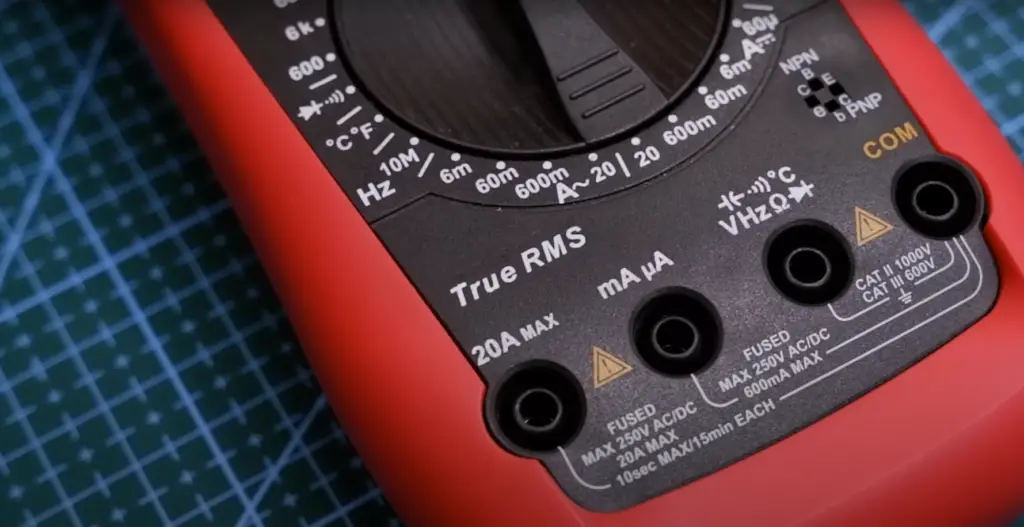
True-RMS multimeters are used for various applications including troubleshooting electric circuits, testing electrical components such as motors and transformers, and calibrating power meters. They can also be helpful for monitoring electric safety hazards by detecting phase imbalance, ground loops and other conditions that could potentially cause serious damage or injury. [1]
How do Digital Multimeters Interpret Sine Waves?
A digital multimeter (DMM) is an instrument that measures the AC and DC voltage, current, temperature and resistance of a circuit. Digital multimeters are commonly used to test electronic components and circuitry in computers, electronic appliances and automotive systems.
One type of digital multimeter is called a True-RMS multimeter. This type of DMM uses Root Mean Square (RMS) technology to read sine waves accurately. RMS is the equivalent heating effect on a resistor of an alternating current with the same peak amplitude as the waveform being measured. This method ensures that non-sinusoidal waveforms can be accurately measured as it eliminates errors caused by irregular variations in amplitude or frequency. With this technology, True-RMS multimeters are able to measure true AC voltage and current levels. They also provide accuracy with signals that contain harmonic distortion, like those found in electrical motors or high frequency switching circuits. With True-RMS technology, users can be confident they are getting the most accurate readings without worrying about errors due to non-sinusoidal waveforms.
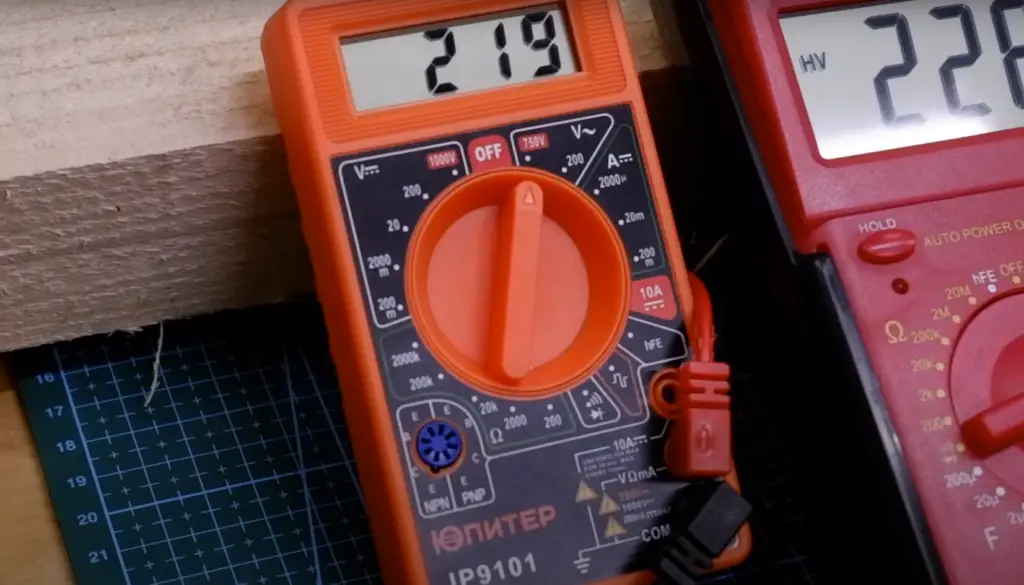
True-RMS multimeters offer a wide range of features including auto ranging, data hold, audible continuity test and diode check functions. Some models also include additional features such as min/max recording and temperature measurement capabilities. [2]
How a True-RMS Meter Works?
It does this by taking an RMS (Root Mean Square) reading from each part of the wave and then mathematically combining them to get an overall average value for the signal.
The advantage of using a true-RMS meter is that it can provide more accurate readings on non-sinusoidal signals such as those produced by electronic components or motors. As a result, it is often used in commercial and industrial settings where these types of signals are common. While traditional meters measure only the peak voltage of a waveform, true-RMS meters can provide a more accurate picture of the total power in a signal. This allows technicians to make more informed decisions when troubleshooting or designing electrical systems.
It is important to note that True RMS meters are not always necessary for all applications, and in some cases may not be the most cost effective option. In these instances, other types of multimeters such as digital, analog or peak-reading meters may be better suited for use. Ultimately, it is important to consider your specific application and budget before making any purchasing decisions.
True-RMS Application in HVAC
True-RMS multimeters can be used in the HVAC industry for a variety of applications. Clamp meters, for instance, are typically utilized to assess the alternating current (AC) voltage and current as well as resistance of motors, blowers, compressors and other elements in a heating or cooling system. When performing maintenance on HVAC systems, accuracy under a range of loads is critical. True-RMS multimeters provide the dependability you need to assess and repair complex machines with confidence.
They also offer faster response times than traditional analog meters, allowing technicians to quickly identify potential problems before they become major issues. Furthermore, a lot of the latest models feature features such as temperature monitoring and data logging which enables technicians to follow system performance over time with ease.
By providing reliable readings in challenging environments, True-RMS multimeters are an invaluable tool for HVAC technicians and engineers. They are durable and easy to use, making them ideal for a wide range of applications.
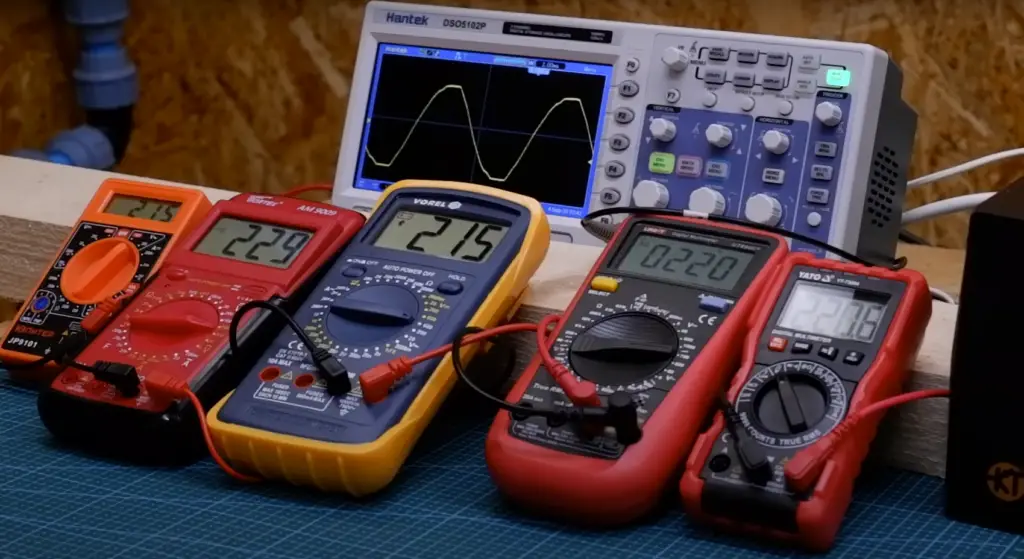
In conclusion, True-RMS multimeters offer many benefits in the HVAC industry, including providing accurate measurements under varying load conditions, faster response times than traditional meters, temperature measurement capabilities and data logging. This makes them an invaluable tool for technicians and engineers alike. [3]
How To Calculate RMS?
The RMS value of a signal can be calculated by taking the square root of the mean of the squares of the signal’s instantaneous amplitudes. This can be written mathematically as:
RMS = √ (1/T) * Σx^2, where x is an instantaneous amplitude and T represents total time.
The RMS value indicates how much power is present in a given set of values; it is usually expressed in units such as volts or watts. In order to calculate the true-RMS value for an AC current, one must first measure both peak-to-peak voltage and frequency before applying this formula. This ensures accuracy for readings on AC signals with different waveforms, such as sine waves and trapezoids.
A true-RMS multimeter is designed to accurately measure the RMS value of AC signals without requiring users to calculate it manually. The device uses an analogue-to-digital converter (ADC) to convert the signal into a set of digital values, which can then be used to calculate the RMS value automatically. Additionally, true-RMS multimeters may also incorporate advanced features such as frequency measurement and data logging capabilities in order to provide more comprehensive readings.
True-RMS multimeters are essential tools for measuring AC power, current, or voltage with accuracy and confidence. With their ability to accurately measure the root mean square of AC signals, they are ideal for scientific research and industrial applications. The use of a true-RMS multimeter can help to ensure accurate readings, as well as provide peace of mind that results are reliable and trustworthy. [4]
What Is The Difference Between True RMS And Normal Multimeter?
This means it takes into account factors like frequency, wave shape, and peaks when calculating its reading. A standard or normal multimeter only reads the average voltage of an AC signal, disregarding any variations in wave shape.
This difference can be important because some signals are not perfectly sinusoidal – meaning they have irregular peaks and troughs to their waveform. In these cases, a true RMS meter will provide more accurate readings than a normal meter as it takes into account all of the fluctuations in the signal instead of just averaging them out. This makes it ideal for use on signals with complex wave forms such as those found in power supplies or variable speed drives.
True RMS meters also have the advantage of being able to measure DC signals, whereas normal multimeters are limited to AC signals only. This makes them more versatile and useful for a wider range of applications.
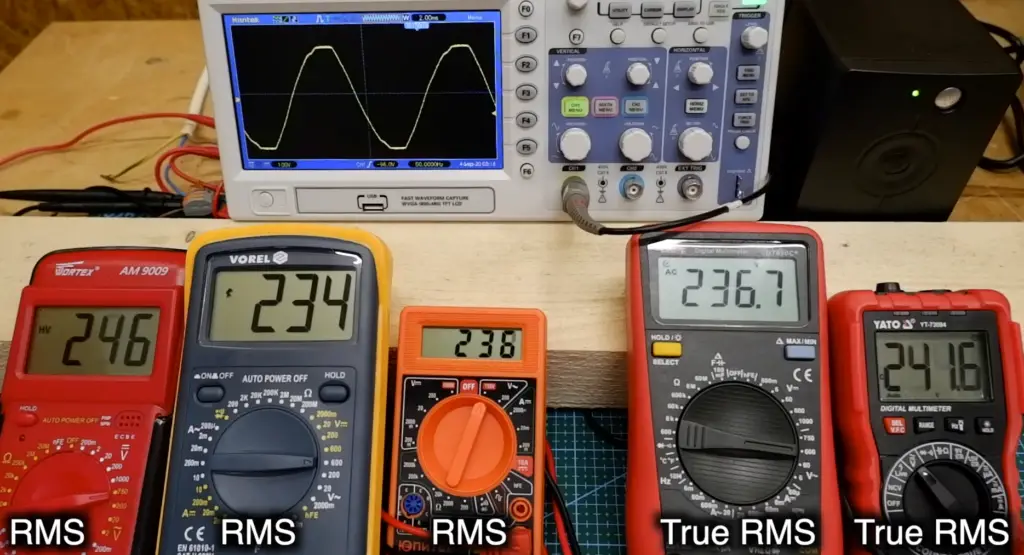
Overall, true RMS meters provide more accurate readings than normal multimeters and can be used for both AC and DC signals. They are best suited for measuring complex waveforms and are often used in industrial settings for precise measurements of power supplies or variable speed drives. [5]
When To Use True RMS Multimeters?
True-RMS multimeters are ideal for measuring non-sinusoidal or distorted waveforms, such as those generated by adjustable speed drives and voltage inverters. This is because True RMS meters take into account the root mean square of the AC waveform to give an accurate representation of its true value – not just of its peak (instantaneous) values.
This makes True RMS multimeters more reliable in readings than traditional digital multimeters which may only measure peak values and can be misleading when measuring irregular waveforms.
Moreover, as many electronic components rely on complex signals, it’s important to have accurate readings which a True RMS meter provides. They also measure resistance, capacitance and inductance with a higher degree of accuracy than traditional multimeters.
In short, if you’re dealing with non-sinusoidal waveforms and need accurate readings, then True RMS Multimeters are the best option to use. They provide reliable readings for complex waveforms that other digital multimeters can’t measure accurately. This makes them ideal for applications in electronics where precise measurements are essential.
How To Identify True RMS Multimeters?
They are designed to be more accurate than traditional average-responding multimeters. To identify a true RMS multimeter, look for the words “True RMS” or “RMS Responding” on the device and its associated literature.
Additionally, check for a range of AC voltage measurements between 0 volts and 600 volts, as this is generally required for true RMS performance. Furthermore, many true RMS devices possess numerical displays that offer enhanced resolution beyond that found on average-responding meters.
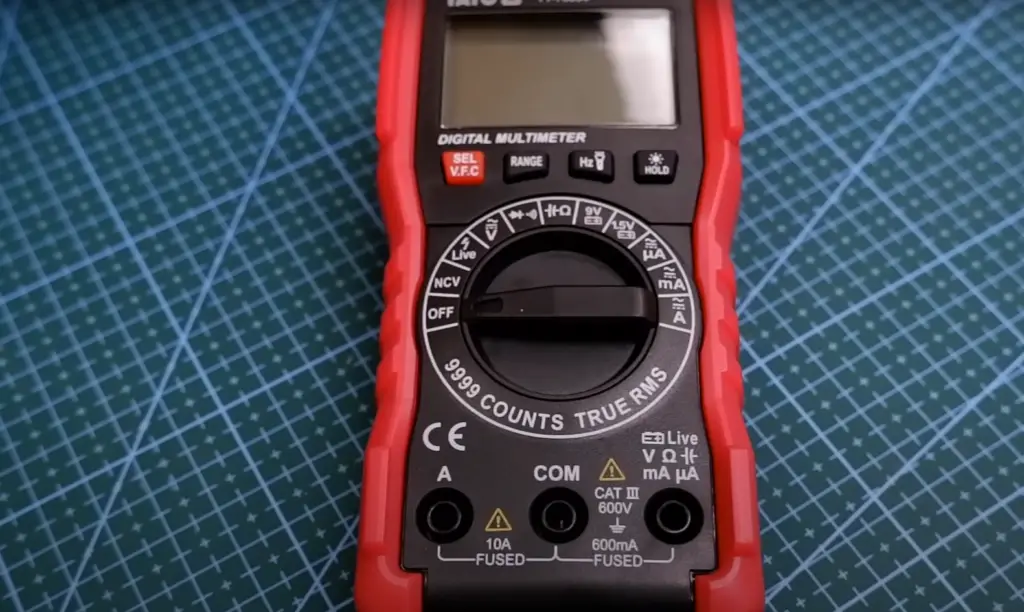
Ultimately, it is important to read up on the specifications of any meter before purchasing it to ensure that it offers the desired capabilities. True RMS multimeters can be used for a variety of tasks, such as measuring AC voltage, current, resistance and capacitance. They are ideal tools for anyone working with AC circuits.
FAQ
Do I need a multimeter with True RMS?
The answer to this question depends on the type of measurements you need to make. If you are measuring mostly AC signals, then a multimeter with True RMS technology is recommended as it will give more accurate and consistent readings than an ordinary multimeter. On the other hand, if you mainly measure DC signals or very low frequency AC, then an ordinary multimeter should suffice. It is important to consider the environment when making this decision – for instance, if there is excessive electrical noise or fast transients present in your measurements, then a True RMS meter would be better suited for that situation. Ultimately it comes down to the specific use-case and what kind of accuracy and precision you require from your measurements.
What is the difference between a true RMS and normal multimeter?
A true RMS multimeter measures the true root mean square (RMS) voltage or current of a signal with an AC waveform, whereas an ordinary multimeter displays only the average value. This is important because many electronic loads, such as motors and lighting systems, are powered by non-sinusoidal signals that can create distortions in the waveform. The true RMS method ensures that these distortions do not affect the measurement accuracy. Moreover, when measuring high-frequency signals, the true RMS method provides more accurate results than other types of multimeters. In contrast, a normal multimeter does not work well for complex waveforms or higher frequency measurements because it will always display only the average value and cannot accurately measure peak values.
What does true RMS mean in a multimeter?
In a multimeter, true RMS means that the meter will measure and display the root mean square (RMS) of an alternating current (AC) signal. The RMS value of a waveform is usually thought of as its effective or heating value. It takes into account both the peak and average values to give an indication of how much power is being delivered by a waveform over time. In other words, it is a measure of the actual power driving the load instead of just measuring the peak values or average values alone.
What is the main disadvantage of a True RMS?
The main disadvantage of a true RMS multimeter is its cost. True RMS meters tend to be more expensive than ordinary multimeters, so they may not be the best choice for some applications where the highest accuracy is not required. Additionally, these meters are usually larger and heavier than other types of meters, which can make them less convenient to carry around. However, if you need accurate AC measurements over a wide range of frequencies and waveforms, then investing in a true RMS meter is probably worth your money.
Why do electricians use RMS?
Electricians use RMS (Root Mean Square) multimeters to measure AC voltage and current, since they provide an accurate representation of actual power. This type of multimeter measures the equivalent heating effect of a particular wave form over a given period of time, which makes it ideal for electrical applications involving complex wave forms. True-RMS multimeters are more expensive than average digital meters but offer superior accuracy, especially when measuring harmonic distortion in AC signals. They also have better noise immunity and can accurately measure both DC and AC signals. By using a True-RMS meter, electricians can be confident that their measurements will be consistent and reliable.
Why is RMS not zero?
RMS is not zero because of the heating effect that AC voltage and current have on a circuit.
This is why it’s important for electricians to use True-RMS multimeters, which measure this heating effect so they can accurately determine how much power is being used in a particular application. Without an accurate reading, circuits could malfunction or be damaged due to incorrect measurements. By using an RMS meter instead of just a normal digital multimeter, electricians can ensure that their measurements are reliable and consistent.
Useful Video: What Is True-RMS And Why Is It So Important?
Conclusion
A true-RMS multimeter is a highly useful tool for measuring voltage, current, and resistance in electrical circuits. It has the advantage of providing more accurate measurements than traditional analog and digital multimeters, particularly when dealing with complex waveforms or distorted signals. Its ability to accurately measure both AC and DC signals makes it an invaluable tool for any technician working on electronics projects. With its wide range of features and functions, a true-RMS multimeter is certainly worth considering for anyone looking for a reliable device to help measure their electrical circuit components.
References
- https://www.keysight.com/us/en/lib/resources/training-materials/tip-1-understand-true-rms-measurements-458364.html
- https://learnabout-electronics.org/ac_theory/ac_waves02.php
- https://www.rockwellautomation.com/en-gb/company/news/magazines/why-is-true-rms-so-important-.html
- https://byjus.com/maths/root-mean-square/
- https://www.fluke.com/en-gb/learn/blog/electrical/what-is-true-rms












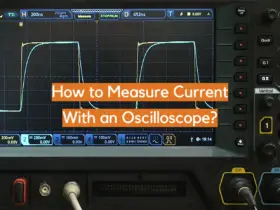

Leave a Reply